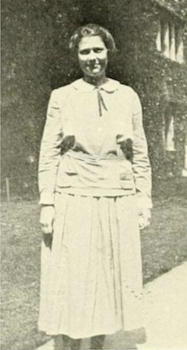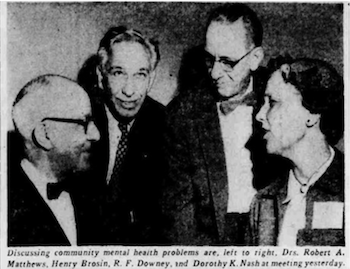
Dorothy Klenke Nash was born to Gertrude and William H. Klenke on October 24, 1898, in Rumson, New Jersey. She attended Miss Spence’s School, a prestigious private school in New York that focuses on liberal arts and graduated in 1917. Her ambition and intellectual ability shone from early on, as she went on to attend Bryn Mawr College in Pennsylvania at a time where it was rare for a woman to seek higher education. Though she was a student at Bryn Mawr, the first spark of her interest in medicine actually came to be at the University of Pennsylvania, where, as a visiting student, Dr. Nash witnessed her first live surgery. Her fascination with medicine only grew from that point onward as she became an active member at Bryn Mawr’s Health Sciences Club. Nearing her graduation from the institution, Dr. Nash started working towards a prospective career in medicine. However, her decision to apply to medical schools was met with disapproval from her parents. In a time where sexist beliefs were engraved in the minds of the masses and women made up a mere 20% of the country’s workforce and a meager 5% of the country’s physicians, the disapproval from Dr. Nash’s parents was no surprise. However, the lack of support from her parents did not stop Dr. Nash from attending Columbia College of Physicians and Surgeons.
After graduating from Columbia in 1925, Dr. Nash started her residency at Bellevue Hospital and decided to specialize in neurosurgery -- a decision said to be influenced by Dr. Bryon Stookey, her mentor and professor at Columbia. Dr. Nash became the first female neurosurgeon in 1928 and remained the only one until 1960. Although it was a great and important feat, Dr. Nash’s contributions to medicine weren’t only shattering the glass wall that restricted women from pursuing neurosurgery. With Dr. Stookey, Dr. Nash prompted the use of lumbar manometry in A Study of Spinal Fluid Pressure in the Differential Diagnosis of Diseases, which is a technology that increased the speed and accuracy of diagnosing spine-related diseases. This shortened the delay between treatment and admittance of patients and ensured appropriate surgical treatment, saving and improving the lives of many patients.

On May 9, 1931, Dr. Nash married Charles B. Nash and, in the following years, gave birth to her two children: George and Dorothy. Contemporaries at that time expected women to sacrifice any sort of career they have after marriage. But in a simple refusal to give into that mindless expectation, Dr. Nash continued her career. However, after the birth of her second child and relocation to Pittsburgh in 1936, Dr. Nash had to put her career on hold. Unfortunately, Dr. Nash could not find a position as a neurosurgeon in Pittsburgh, either because of the sexism and misogyny in the industry or simply because there was no need for another neurosurgeon in the area. Still, this impediment did not deter Dr. Nash’s desire to help and give back to her community through medicine, as she instead chose to work as a phlebotomist at a local blood bank. As World War II commenced and demanded soldiers, more and more men left their everyday jobs to fight, so women, including Dr. Nash, stepped up. Dr. Nash increased her efforts and started volunteering at local military hospitals and the Red Cross as a first aid instructor. In 1942, a job vacancy allowed Dr. Nash to temporarily join the staff of St. Margaret’s Hospital. Her position at St. Margaret’s surgical department was made permanent given her hard work and skill. She also decided to join the University of Pennsylvania’s neurosurgery department around the same time and soon became the head of the department. Dr. Nash was also affiliated with the surgical departments of the Western Pennsylvania Hospital and the Children’s Hospital.

As a pioneer for women in neurosurgery, Dr. Nash often gave lectures to women, encouraging them to pursue medicine. After being named a Distinguished Daughter of Pennsylvania, an honor reserved for women who contribute greatly to the state of Pennsylvania, she continued to uplift other Pennsylvanian women as the president of the organization. Dr. Nash was also a lifelong advocate for children’s health and welfare, which was reflected through her founding of the Cerebral Palsy Association that aimed to educate people of the neurological condition, known commonly to surface during childhood, and to help people who have it. As a founder of the Mental Health Society of Allegheny County, Dr. Nash helped spread important information about mental health and strived to destigmatize the topic, speaking at multiple events to emphasize the importance of mental health. She also served as the first female president of the Pittsburgh Neuropsychiatric Society.
Along with being honored as a Distinguished Daughter of Pennsylvania for her numerous achievements, Dr. Nash was also awarded the Minerva Award, symbolically named after the Roman goddess of wisdom, from the Women’s Auxiliary of Mercy Hospital in 1957. Following her retirement from medicine in 1965, she received a commemorative medallion from Columbia. Dr. Nash passed away in 1976. She lived a life dedicated to the welfare of others, shown through her volunteer work and advocacy for mental health awareness and children’s health. During her career, she made vital contributions to the field of neurosurgery and left a road carved out for many women to follow.
Why Did I Choose to Research Dr. Dorothy Klenke Nash?
The underrepresentation of women in medicine is no secret: historically, women have been excluded from medical education and the workforce and have even been excluded from taking part in clinical trials, leading to stark contrasts between reactions of drugs across sexes. As someone who takes great interest in neurosurgery, I was appalled to see that only twelve percent of the U.S.’ neurosurgeons is made up of women. Hence, I decided to research the woman who opened up the path to neurosurgery for American women for many generations to come.
Works Cited
Casillo, S. M., Venkatesh, A., Muthiah, N., Agarwal, N., Scott, T., Romani, R., Fernández, L. L., Aristizabal, S., Ginalis, E. E., Ozair, A., Bhat, V., Faruqi, A., Bajaj, A., Sonkar, A. A., Ikeda, D. S., Chiocca, E. A., Lonser, R. R., Sutton, T. E., McGregor, J. M., … Wang, M. Y. (2021, March 1). Biographies of International Women Leaders in neurosurgery. Journal of Neurosurgery. Retrieved from https://thejns.org/focus/view/journals/neurosurg-focus/50/3/article-pE19.xml?tab_body=pdf-24076
Dr. Dorothy K. Nash, Neurosurgeon, Dies. (1976, March 6). The New York Times. Retrieved from https://www.nytimes.com/1976/03/06/archives/dr-dorothy-k-nash-neurosurgeon-dies.html
Dr. Mark R. McLaughlin. (n.d.). Dorothy Klenke Nash, M.D. : Pioneer Woman and neurosurgeon. Mark R McLaughlin MD. Retrieved from https://www.markmclaughlinmd.com/articles/dorothy-klenke-nash-md-pioneer-woman-and-neurosurgeon
Johnson, R. (2022, April 8). Closing the Gap. Pittsburgh Post-Gazette. Retrieved from https://www.pressreader.com/usa/pittsburgh-post-gazette/20220408/281840057196985
Mental Health Viewpoint Giv. (1963, May 1). New Castle News, p. 3. Retrieved from https://newscomwc.newspapers.com/image/72728675/?terms=dr.%20dorothy%20k.%20nash&pqsid=OqW24OgbBEpk8erwiZ6PVg%3A1147000%3A2084391884&match=1
Odell, T., Toor, H., Takayanagi, A., Zampella, B., Siddiqi, J., Jalal, S., Golbaz, K., Qamar, S., & Khosa, F. (2019). Gender Disparity in Academic Neurosurgery. Cureus, 11(5), e4628. https://doi.org/10.7759/cureus.4628
The Spence School: A private K-12 all-girls' school in Manhattan. The Spence School | A Private K-12 All-Girls' School in Manhattan. (n.d.). Retrieved from https://www.spenceschool.org/
Will Honor State Women. (1953, October 5). The Plain Speaker, p. 14. Retrieved from https://newscomwc.newspapers.com/image/503629402/?terms=dorothy%20Klenke%20nash&pqsid=zdhHut1EOQc_b7uyLPevzg%3A1683000%3A2057979617&match=1
This article was published on 2/16/24